Design Problem-Solving Methodologies in IT Engineering Projects
VerifiedAdded on 2023/06/15
|6
|1276
|205
Report
AI Summary
This report discusses design problem-solving methodologies relevant to Information Technology Practice and Engineering, emphasizing the conception, establishment, utilization, modification, maintenance, and retirement of artifacts. It highlights the complex nature of engineering problems, characterized by ill-defined problem statements, open-ended solutions, and initial information scarcity. The report underscores the shift in engineering education towards incorporating conceptual, innovative, and creative design aspects. It elaborates on the systems approach and analysis necessitated by the increasing complexity of engineering projects, advocating for team-based approaches led by a lead engineer. The report uses the example of pipeline optimization to illustrate the application of problem-solving approaches, focusing on cost optimization relative to pipe and pump sizes. It further discusses synthesis of alternative solutions and decision-making methodologies for efficient and sustainable outcomes, using a farm irrigation system as an implementation example. The document concludes by referencing key works in design problem-solving and e-learning.
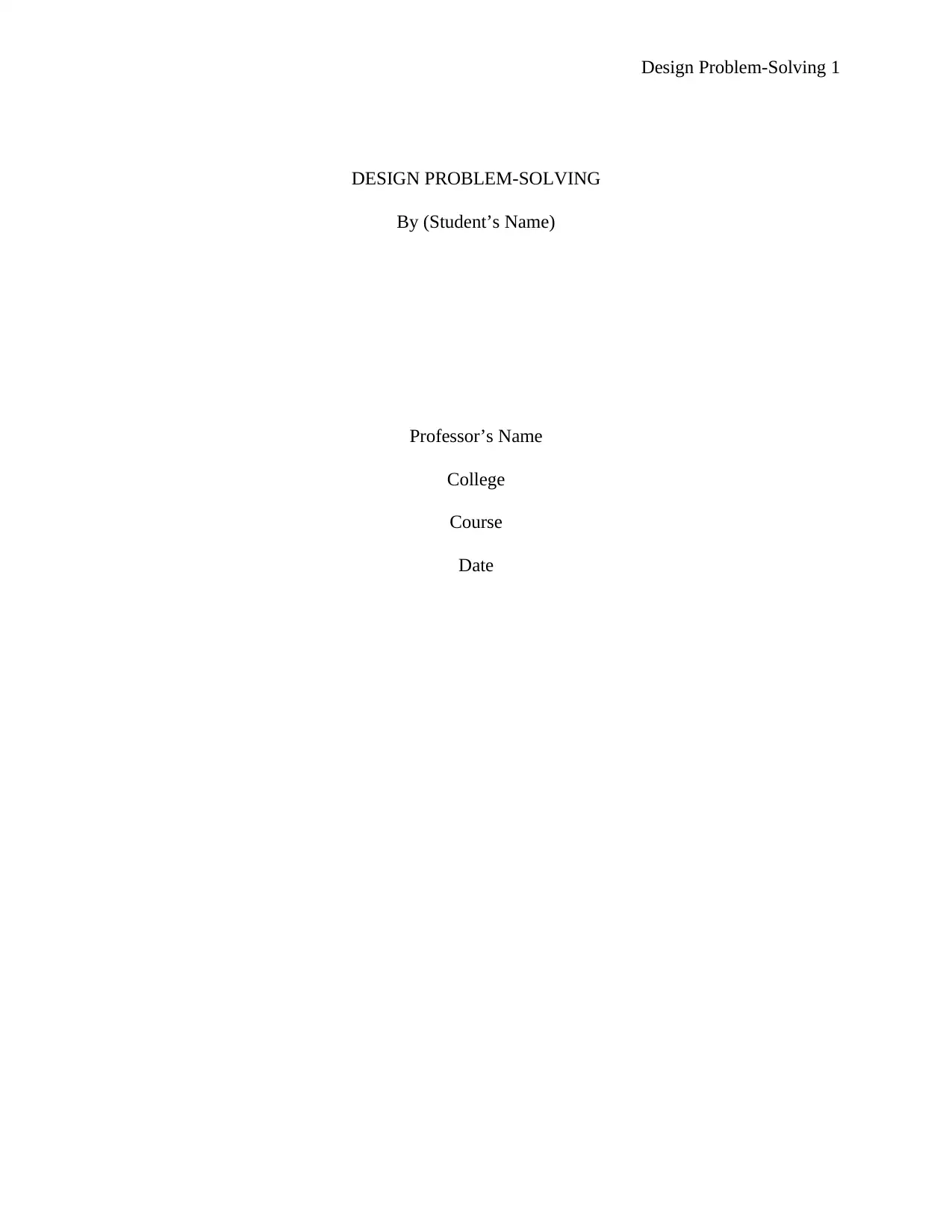
Design Problem-Solving 1
DESIGN PROBLEM-SOLVING
By (Student’s Name)
Professor’s Name
College
Course
Date
DESIGN PROBLEM-SOLVING
By (Student’s Name)
Professor’s Name
College
Course
Date
Paraphrase This Document
Need a fresh take? Get an instant paraphrase of this document with our AI Paraphraser
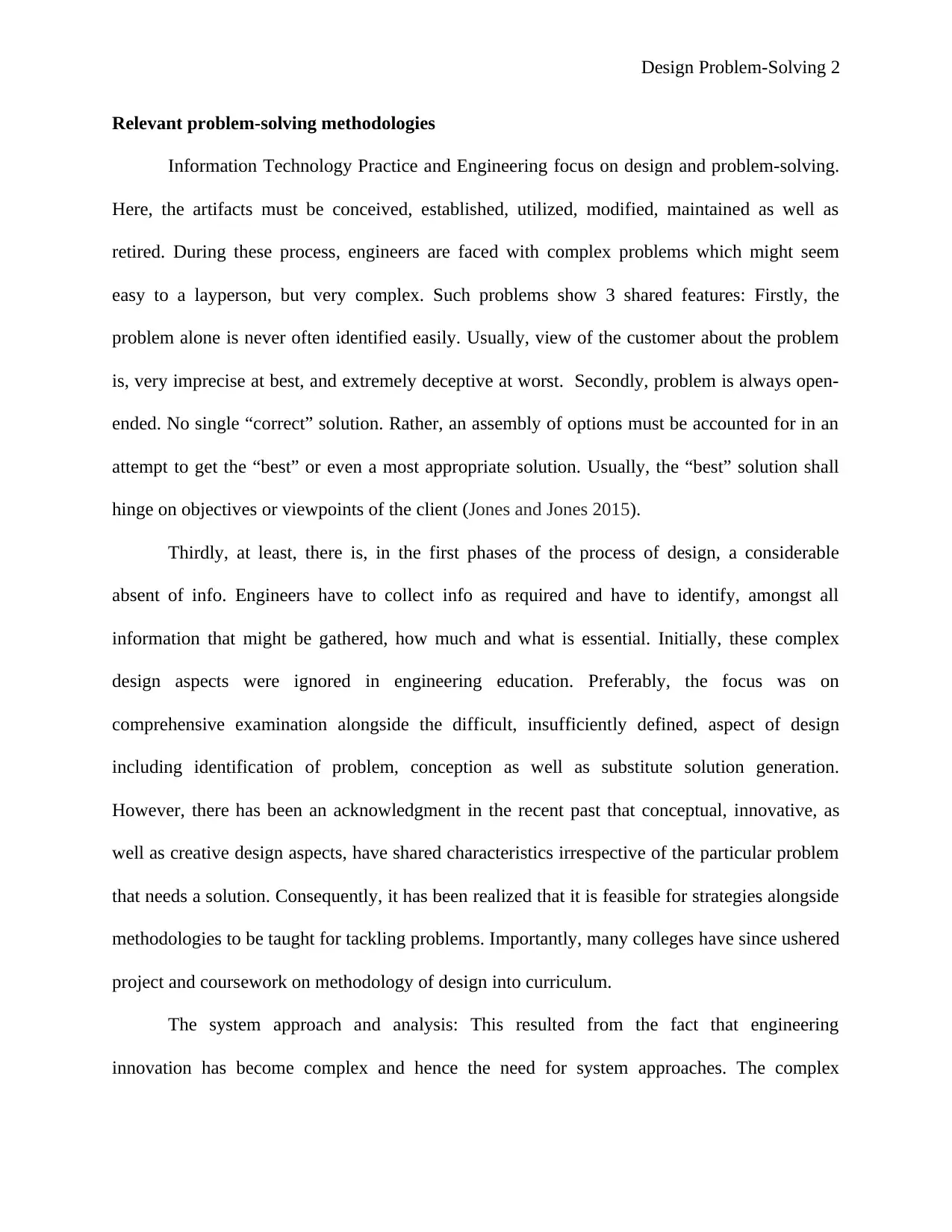
Design Problem-Solving 2
Relevant problem-solving methodologies
Information Technology Practice and Engineering focus on design and problem-solving.
Here, the artifacts must be conceived, established, utilized, modified, maintained as well as
retired. During these process, engineers are faced with complex problems which might seem
easy to a layperson, but very complex. Such problems show 3 shared features: Firstly, the
problem alone is never often identified easily. Usually, view of the customer about the problem
is, very imprecise at best, and extremely deceptive at worst. Secondly, problem is always open-
ended. No single “correct” solution. Rather, an assembly of options must be accounted for in an
attempt to get the “best” or even a most appropriate solution. Usually, the “best” solution shall
hinge on objectives or viewpoints of the client (Jones and Jones 2015).
Thirdly, at least, there is, in the first phases of the process of design, a considerable
absent of info. Engineers have to collect info as required and have to identify, amongst all
information that might be gathered, how much and what is essential. Initially, these complex
design aspects were ignored in engineering education. Preferably, the focus was on
comprehensive examination alongside the difficult, insufficiently defined, aspect of design
including identification of problem, conception as well as substitute solution generation.
However, there has been an acknowledgment in the recent past that conceptual, innovative, as
well as creative design aspects, have shared characteristics irrespective of the particular problem
that needs a solution. Consequently, it has been realized that it is feasible for strategies alongside
methodologies to be taught for tackling problems. Importantly, many colleges have since ushered
project and coursework on methodology of design into curriculum.
The system approach and analysis: This resulted from the fact that engineering
innovation has become complex and hence the need for system approaches. The complex
Relevant problem-solving methodologies
Information Technology Practice and Engineering focus on design and problem-solving.
Here, the artifacts must be conceived, established, utilized, modified, maintained as well as
retired. During these process, engineers are faced with complex problems which might seem
easy to a layperson, but very complex. Such problems show 3 shared features: Firstly, the
problem alone is never often identified easily. Usually, view of the customer about the problem
is, very imprecise at best, and extremely deceptive at worst. Secondly, problem is always open-
ended. No single “correct” solution. Rather, an assembly of options must be accounted for in an
attempt to get the “best” or even a most appropriate solution. Usually, the “best” solution shall
hinge on objectives or viewpoints of the client (Jones and Jones 2015).
Thirdly, at least, there is, in the first phases of the process of design, a considerable
absent of info. Engineers have to collect info as required and have to identify, amongst all
information that might be gathered, how much and what is essential. Initially, these complex
design aspects were ignored in engineering education. Preferably, the focus was on
comprehensive examination alongside the difficult, insufficiently defined, aspect of design
including identification of problem, conception as well as substitute solution generation.
However, there has been an acknowledgment in the recent past that conceptual, innovative, as
well as creative design aspects, have shared characteristics irrespective of the particular problem
that needs a solution. Consequently, it has been realized that it is feasible for strategies alongside
methodologies to be taught for tackling problems. Importantly, many colleges have since ushered
project and coursework on methodology of design into curriculum.
The system approach and analysis: This resulted from the fact that engineering
innovation has become complex and hence the need for system approaches. The complex
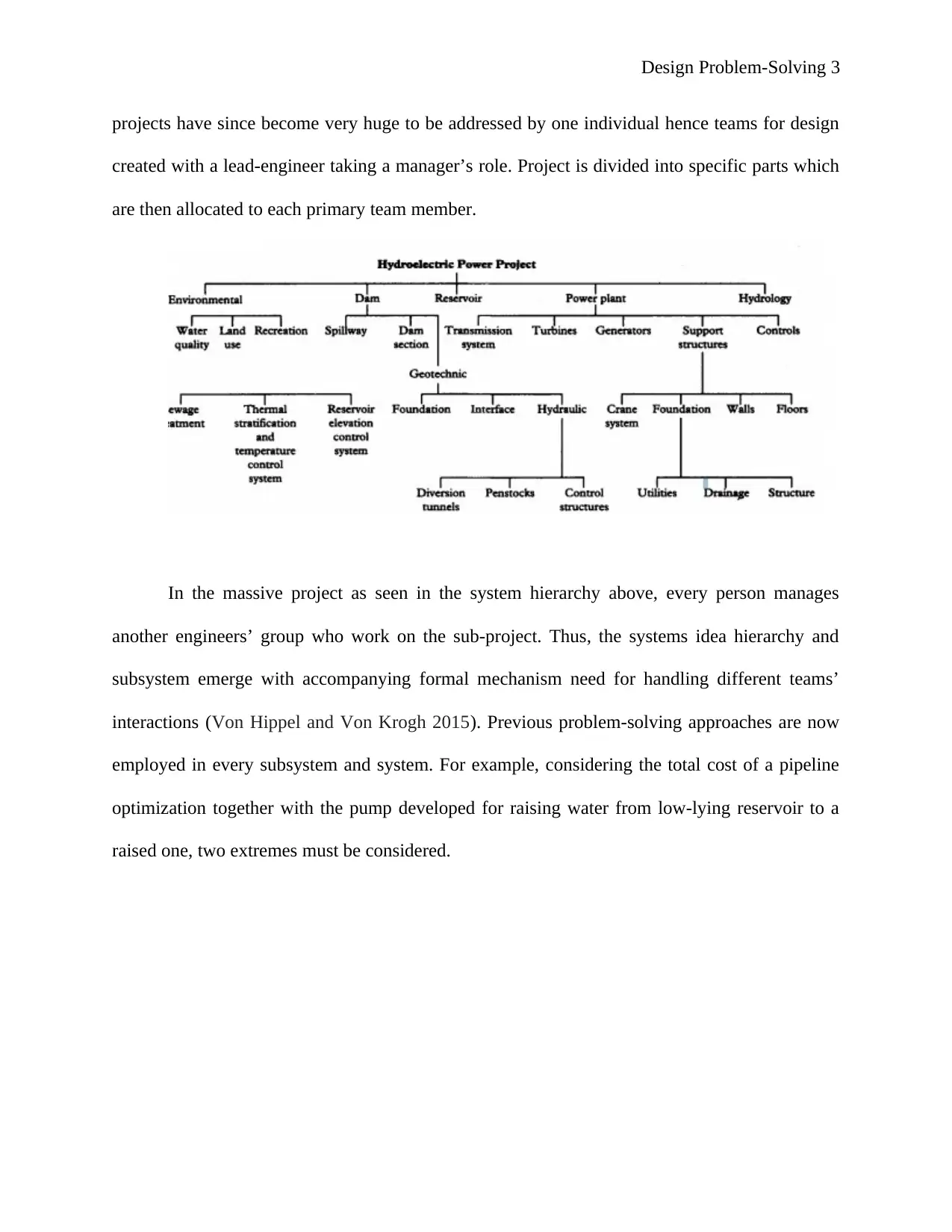
Design Problem-Solving 3
projects have since become very huge to be addressed by one individual hence teams for design
created with a lead-engineer taking a manager’s role. Project is divided into specific parts which
are then allocated to each primary team member.
In the massive project as seen in the system hierarchy above, every person manages
another engineers’ group who work on the sub-project. Thus, the systems idea hierarchy and
subsystem emerge with accompanying formal mechanism need for handling different teams’
interactions (Von Hippel and Von Krogh 2015). Previous problem-solving approaches are now
employed in every subsystem and system. For example, considering the total cost of a pipeline
optimization together with the pump developed for raising water from low-lying reservoir to a
raised one, two extremes must be considered.
projects have since become very huge to be addressed by one individual hence teams for design
created with a lead-engineer taking a manager’s role. Project is divided into specific parts which
are then allocated to each primary team member.
In the massive project as seen in the system hierarchy above, every person manages
another engineers’ group who work on the sub-project. Thus, the systems idea hierarchy and
subsystem emerge with accompanying formal mechanism need for handling different teams’
interactions (Von Hippel and Von Krogh 2015). Previous problem-solving approaches are now
employed in every subsystem and system. For example, considering the total cost of a pipeline
optimization together with the pump developed for raising water from low-lying reservoir to a
raised one, two extremes must be considered.
⊘ This is a preview!⊘
Do you want full access?
Subscribe today to unlock all pages.

Trusted by 1+ million students worldwide
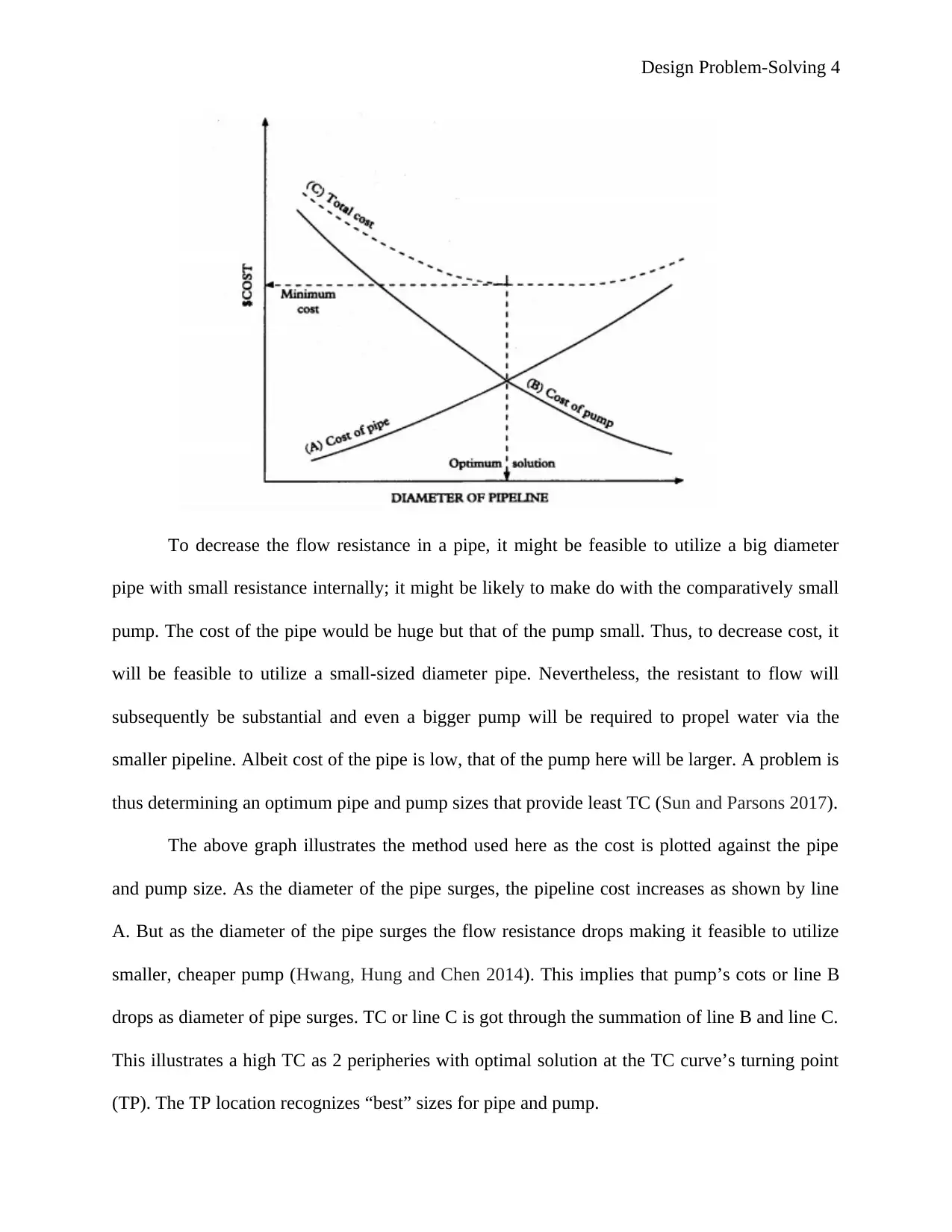
Design Problem-Solving 4
To decrease the flow resistance in a pipe, it might be feasible to utilize a big diameter
pipe with small resistance internally; it might be likely to make do with the comparatively small
pump. The cost of the pipe would be huge but that of the pump small. Thus, to decrease cost, it
will be feasible to utilize a small-sized diameter pipe. Nevertheless, the resistant to flow will
subsequently be substantial and even a bigger pump will be required to propel water via the
smaller pipeline. Albeit cost of the pipe is low, that of the pump here will be larger. A problem is
thus determining an optimum pipe and pump sizes that provide least TC (Sun and Parsons 2017).
The above graph illustrates the method used here as the cost is plotted against the pipe
and pump size. As the diameter of the pipe surges, the pipeline cost increases as shown by line
A. But as the diameter of the pipe surges the flow resistance drops making it feasible to utilize
smaller, cheaper pump (Hwang, Hung and Chen 2014). This implies that pump’s cots or line B
drops as diameter of pipe surges. TC or line C is got through the summation of line B and line C.
This illustrates a high TC as 2 peripheries with optimal solution at the TC curve’s turning point
(TP). The TP location recognizes “best” sizes for pipe and pump.
To decrease the flow resistance in a pipe, it might be feasible to utilize a big diameter
pipe with small resistance internally; it might be likely to make do with the comparatively small
pump. The cost of the pipe would be huge but that of the pump small. Thus, to decrease cost, it
will be feasible to utilize a small-sized diameter pipe. Nevertheless, the resistant to flow will
subsequently be substantial and even a bigger pump will be required to propel water via the
smaller pipeline. Albeit cost of the pipe is low, that of the pump here will be larger. A problem is
thus determining an optimum pipe and pump sizes that provide least TC (Sun and Parsons 2017).
The above graph illustrates the method used here as the cost is plotted against the pipe
and pump size. As the diameter of the pipe surges, the pipeline cost increases as shown by line
A. But as the diameter of the pipe surges the flow resistance drops making it feasible to utilize
smaller, cheaper pump (Hwang, Hung and Chen 2014). This implies that pump’s cots or line B
drops as diameter of pipe surges. TC or line C is got through the summation of line B and line C.
This illustrates a high TC as 2 peripheries with optimal solution at the TC curve’s turning point
(TP). The TP location recognizes “best” sizes for pipe and pump.
Paraphrase This Document
Need a fresh take? Get an instant paraphrase of this document with our AI Paraphraser
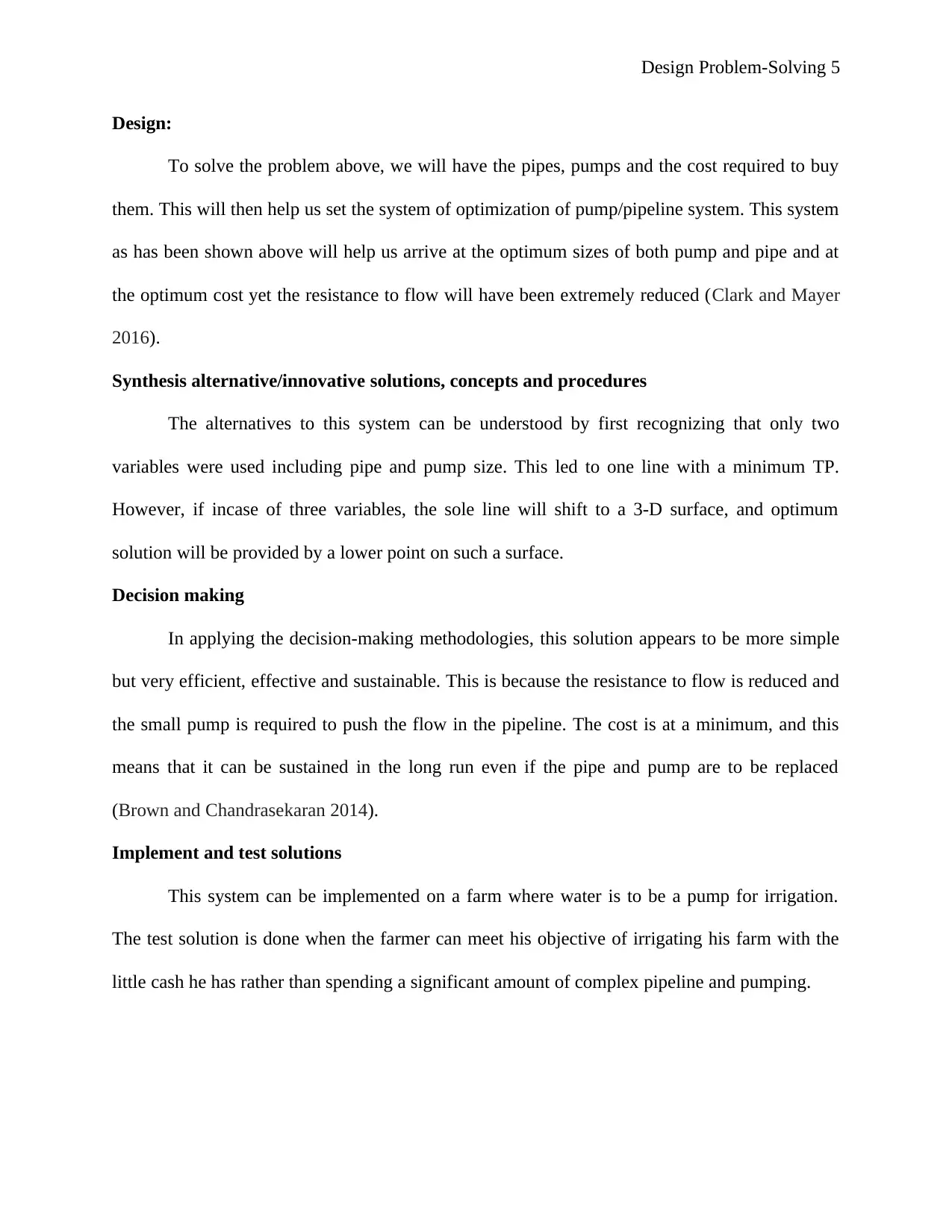
Design Problem-Solving 5
Design:
To solve the problem above, we will have the pipes, pumps and the cost required to buy
them. This will then help us set the system of optimization of pump/pipeline system. This system
as has been shown above will help us arrive at the optimum sizes of both pump and pipe and at
the optimum cost yet the resistance to flow will have been extremely reduced (Clark and Mayer
2016).
Synthesis alternative/innovative solutions, concepts and procedures
The alternatives to this system can be understood by first recognizing that only two
variables were used including pipe and pump size. This led to one line with a minimum TP.
However, if incase of three variables, the sole line will shift to a 3-D surface, and optimum
solution will be provided by a lower point on such a surface.
Decision making
In applying the decision-making methodologies, this solution appears to be more simple
but very efficient, effective and sustainable. This is because the resistance to flow is reduced and
the small pump is required to push the flow in the pipeline. The cost is at a minimum, and this
means that it can be sustained in the long run even if the pipe and pump are to be replaced
(Brown and Chandrasekaran 2014).
Implement and test solutions
This system can be implemented on a farm where water is to be a pump for irrigation.
The test solution is done when the farmer can meet his objective of irrigating his farm with the
little cash he has rather than spending a significant amount of complex pipeline and pumping.
Design:
To solve the problem above, we will have the pipes, pumps and the cost required to buy
them. This will then help us set the system of optimization of pump/pipeline system. This system
as has been shown above will help us arrive at the optimum sizes of both pump and pipe and at
the optimum cost yet the resistance to flow will have been extremely reduced (Clark and Mayer
2016).
Synthesis alternative/innovative solutions, concepts and procedures
The alternatives to this system can be understood by first recognizing that only two
variables were used including pipe and pump size. This led to one line with a minimum TP.
However, if incase of three variables, the sole line will shift to a 3-D surface, and optimum
solution will be provided by a lower point on such a surface.
Decision making
In applying the decision-making methodologies, this solution appears to be more simple
but very efficient, effective and sustainable. This is because the resistance to flow is reduced and
the small pump is required to push the flow in the pipeline. The cost is at a minimum, and this
means that it can be sustained in the long run even if the pipe and pump are to be replaced
(Brown and Chandrasekaran 2014).
Implement and test solutions
This system can be implemented on a farm where water is to be a pump for irrigation.
The test solution is done when the farmer can meet his objective of irrigating his farm with the
little cash he has rather than spending a significant amount of complex pipeline and pumping.
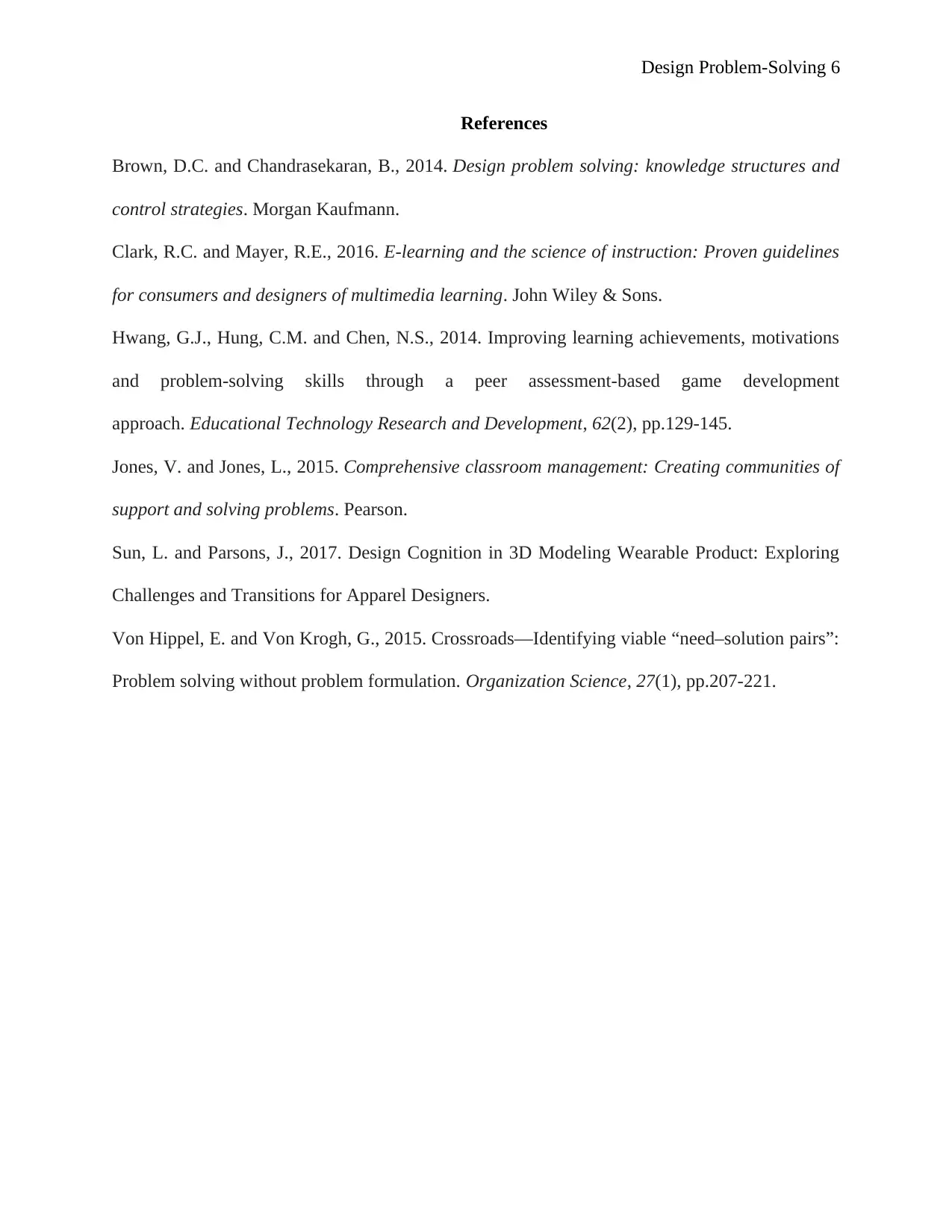
Design Problem-Solving 6
References
Brown, D.C. and Chandrasekaran, B., 2014. Design problem solving: knowledge structures and
control strategies. Morgan Kaufmann.
Clark, R.C. and Mayer, R.E., 2016. E-learning and the science of instruction: Proven guidelines
for consumers and designers of multimedia learning. John Wiley & Sons.
Hwang, G.J., Hung, C.M. and Chen, N.S., 2014. Improving learning achievements, motivations
and problem-solving skills through a peer assessment-based game development
approach. Educational Technology Research and Development, 62(2), pp.129-145.
Jones, V. and Jones, L., 2015. Comprehensive classroom management: Creating communities of
support and solving problems. Pearson.
Sun, L. and Parsons, J., 2017. Design Cognition in 3D Modeling Wearable Product: Exploring
Challenges and Transitions for Apparel Designers.
Von Hippel, E. and Von Krogh, G., 2015. Crossroads—Identifying viable “need–solution pairs”:
Problem solving without problem formulation. Organization Science, 27(1), pp.207-221.
References
Brown, D.C. and Chandrasekaran, B., 2014. Design problem solving: knowledge structures and
control strategies. Morgan Kaufmann.
Clark, R.C. and Mayer, R.E., 2016. E-learning and the science of instruction: Proven guidelines
for consumers and designers of multimedia learning. John Wiley & Sons.
Hwang, G.J., Hung, C.M. and Chen, N.S., 2014. Improving learning achievements, motivations
and problem-solving skills through a peer assessment-based game development
approach. Educational Technology Research and Development, 62(2), pp.129-145.
Jones, V. and Jones, L., 2015. Comprehensive classroom management: Creating communities of
support and solving problems. Pearson.
Sun, L. and Parsons, J., 2017. Design Cognition in 3D Modeling Wearable Product: Exploring
Challenges and Transitions for Apparel Designers.
Von Hippel, E. and Von Krogh, G., 2015. Crossroads—Identifying viable “need–solution pairs”:
Problem solving without problem formulation. Organization Science, 27(1), pp.207-221.
⊘ This is a preview!⊘
Do you want full access?
Subscribe today to unlock all pages.

Trusted by 1+ million students worldwide
1 out of 6
Your All-in-One AI-Powered Toolkit for Academic Success.
+13062052269
info@desklib.com
Available 24*7 on WhatsApp / Email
![[object Object]](/_next/static/media/star-bottom.7253800d.svg)
Unlock your academic potential
Copyright © 2020–2025 A2Z Services. All Rights Reserved. Developed and managed by ZUCOL.